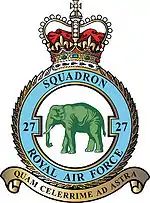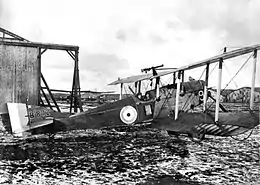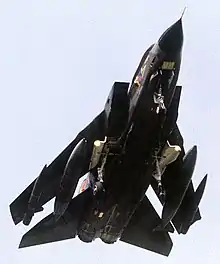No. 27 Squadron RAF
No. 27 Squadron of the Royal Air Force operates the Boeing Chinook from RAF Odiham.
| No. 27 Squadron RAF | |
|---|---|
 | |
| Active |
|
| Country | |
| Branch | |
| Type | Flying squadron |
| Role | Helicopter heavy-lift support |
| Part of | Joint Helicopter Command |
| Home station | RAF Odiham |
| Motto(s) | Quam celerrime ad astra (Latin for 'With all speed to the Stars')[1] |
| Aircraft | Boeing Chinook HC5,HC6a |
| Battle honours |
|
| Insignia | |
| Squadron badge heraldry | An elephant, based on an unofficial emblem first used in 1934 and commemorating the squadron's first operational aircraft (the Martinsyde G100 Elephant) and the unit's association with India. Approved by King Edward VIII in October 1936. |
History
First World War

27 Squadron formed at Hounslow Heath Aerodrome on 5 November 1915, soon being equipped with Martinsyde Elephant fighter aircraft, hence the use of an elephant for the squadron badge.[2] It transferred to France early in 1916, but although initially using their aircraft as escort fighters, by the time the Battle of the Somme began, it was clear that the Elephant was unsuitable as a fighter, and the Squadron switched to a bomber-reconnaissance role, taking advantage of the Martinsyde's good range and load carrying capacity,carrying out its first bombing mission on 1 July 1916.[3]
It re-equipped with Airco DH.4s, which carried twice the bombload of the Martinsyde at greater speed and height, while carrying a gunner to defend against enemy fighters, from between September and November 1917, flying missions in support of the British offensive at Cambrai, and low level missions against the attacking German troops during the Spring Offensive of 1918. It started to receive DH.9 bombers in July 1918, but as these proved to be inferior to the DH.4, managed to keep some of its DH.4s until the end of the war. The squadron was disbanded on 22 January 1920.[4]
Inter-war period
On 1 April 1920, No. 27 was reformed by re-numbering No. 99 Squadron RAF then in India, flying Airco DH.9A light bombers from Risalpur over the North-West Frontier. These aircraft were eventually replaced by Westland Wapitis in 1928, when the squadron moved to Kohat.[5] In December 1928, Flying Officer Tusk and Leading Aircraftman Donaldson (both of 27 Squadron), flew the first mission of the Kabul Airlift. Strictly a reconnaissance flight to ascertain the situation of the British Legation in Kabul during a civil war, they were shot at by local tribesmen and forced to land at a nearby airstrip. After this they managed to dash across no-man's land and arrived at the legation to set up communications with their home base of Risalpur.[6]
In October 1939, the squadron became a flying training school, operating de Havilland Tiger Moth and Hawker Hart biplanes as well as Wapitis, but was re-equipped with Bristol Blenheim bombers by the end of 1940.[7][2]
War in the East
It was based in Malaya when the Japanese invaded, using its Blenheims as long range fighters, but quickly received heavy losses and was effectively wiped out as a fighting unit by early 1942.[5][7]
A new No. 27 Squadron was formed in India on 19 September 1942, receiving Bristol Beaufighters, using them for ground-attack missions over Burma and anti-shipping strikes.[8] In April 1943, the squadron received a number of de Havilland Mosquitoes for evaluation, and a flight was re-equipped with Mosquitoes in December that year.[9] The glue-and-plywood construction of the otherwise excellent Mosquito proved to be less than optimal for tropical Burma, and the operations where plagued by technical problems.[10] They eventually relinquished the Mosquitoes to No. 680 Squadron RAF, retaining the Beaufighters and continuing the Squadron's diet of ground attack and anti-shipping strikes, switching to air-jungle rescue in April 1945.[2][9]
Following the Japanese surrender, it was deployed to Batavia during the Indonesian War of Independence, being disbanded on 1 February 1946.[2][9]
Post-war service
On 24 November 1947, the squadron reformed at RAF Oakington as a Transport unit equipped with Douglas Dakota transports. It flew both routine scheduled transport routes and trained in glider towing, and took part in the Berlin Airlift in 1948–49. It was disbanded on 10 November 1950.[9] On 15 June 1953, No. 27 Squadron reformed at RAF Scampton as part of RAF Bomber Command, with Canberra bombers. It took part in the Suez Crisis in 1956, and was disbanded at RAF Waddington on 31 December 1957.[9]

In April 1961, the squadron reformed at RAF Scampton as the first squadron to be equipped with the Avro Vulcan B2 V bomber[11] and formed part of the UK nuclear deterrent strike force. The squadron's Vulcans were equipped with the Blue Steel one megaton stand-off bomb until 1969 when their eight aircraft were each re-equipped with a WE.177B laydown bomb[12] of 450 kt yield. The squadron's role assigned to SACEUR in a low-level penetration role was tactical support for ground forces resisting a Soviet land attack into Western Europe by striking targets assigned by SACEUR, beyond the forward edge of the battlefield, and deep into enemy-held areas.[13] By the end of 1971 the squadron had relinquished its nuclear delivery role, and stood down until in December 1973 it was reformed at RAF Scampton with the Vulcan B2 to operate in the Maritime Radar Reconnaissance (MRR) role assigned to SACLANT.[2]
From 1973 to 1982 the squadron performed the duties of 'Strategic Reconnaissance' with onboard equipment to monitor the fall-out from air and ground-based nuclear tests being performed by emerging nuclear powers in the Indian sub-continent and SE Asia. The squadron's Vulcan B2s were modified (and re-designated as "Vulcan B.2 (MRR)") to carry underwing 'sniffer' and collection equipment to detect and collect samples of airborne contamination for later analysis at the Atomic Weapons Research Establishment (AWRE) at Aldermaston. The samples were collected by flying through the high altitude dust cloud of a ground-based test or the downwind contamination of the upper atmosphere after an air burst. The squadron disbanded again at Scampton in 1982.[2]

The squadron reformed again at RAF Marham in 1983 with twelve Tornado GR1 aircraft and eighteen WE.177 nuclear bombs, and once again assigned to SACEUR in 1984,[14] the squadron's role was low-level penetration tactical support for ground forces resisting a Soviet land attack into Western Europe by striking targets beyond the forward edge of the battlefield. The squadron's allocation of eighteen WE.177 weapons was because of the greater carrying capacity of the Tornado, which could carry two weapons. The apparent mismatch between twelve Tornado aircraft and eighteen nuclear weapons was because RAF staff planners expected up to one third attrition of aircraft in the conventional phase, with sufficient aircraft held back in reserve to deliver the squadron's full stock of nuclear weapons if the conflict escalated to the use of tactical nuclear weapons. In September 1993, the squadron's Tornado aircraft and personnel moved to RAF Lossiemouth and took on the number plate of No. 12 Squadron which had recently disbanded at RAF Marham.[15]
Helicopters

The No. 27 Squadron number plate was transferred to RAF Odiham and became No. 27 (Reserve) Squadron, the Chinook/Puma Operational Conversion Unit,[16] formerly No. 240 Operational Conversion Unit RAF (OCU). It regained full squadron status in January 1998 equipped with Chinooks only. In 2002 the squadron's Chinooks saw service in Afghanistan as they transported Royal Marines from 3 Commando Brigade for Operation Jacana.[17]
The squadron also served in a transport role during the 2003 invasion of Iraq and was stationed at Basra as part of No. 1310 Flight RAF, supporting Operation Telic.[18] In July 2006, 3 Chinook helicopters of No.27 Squadron deployed to RAF Akrotiri in Cyprus to evacuate British citizens from Lebanon.[19] It deployed to Afghanistan for Operation Herrick in 2011.[20]
In March 2020, the squadron was awarded the right to emblazon a battle honour on its squadron standard, recognising its role in the War in Afghanistan between 2001 and 2014.[21]
Aircraft operated
| Dates | Aircraft | Variant | Notes |
|---|---|---|---|
| 1915 | Various aircraft inherited from No. 24 Squadron RFC | ||
| 1916–1917 | Martynside G.100 and 102 | Single-engined biplane fighter bomber | |
| 1917–1918 | Airco DH.4 | Single-engined biplane day bomber | |
| 1918–1919 | de Havilland DH.9 | Single-engined biplane bomber | |
| 1930–1940 | Westland Wapiti | Single-engined general purpose biplane | |
| 1939–1940 | de Havilland Tiger Moth | Single-engined biplane trainer | |
| 1939–1940 | Hawker Hart | Single-engined biplane light bomber | |
| 1940–1942 | Bristol Blenheim | IF | Twin-engined light bomber |
| 1942–1944 | Bristol Beaufighter | VIF | Twin-engined ground attack |
| 1943 1943–1944 |
de Havilland Mosquito | II VI |
Twin-engined light bomber |
| 1943–1946 | Bristol Beaufighter | X | Twin-engined ground attack |
| 1947–1950 | Douglas Dakota | Twin-engined transport | |
| 1953–1957 | English Electric Canberra | B2 | Twin-engined light bomber |
| 1961–1972 1973–1983 |
Avro Vulcan | B2 B2(MRR) |
Four-engined V-Bomber |
| 1983–1993 | Panavia Tornado | GR1 | Twin-engined ground attack/bomber |
| 1993–present | Boeing Chinook | HC2,2A,3,4,4A,5,6A | Twin-rotor transport helicopter |
Cultural references
In 2007, Olly Lambert made a documentary for the BBC about a two-month deployment of 27 Squadron in Helmand, Afghanistan. It documented the daily routines and work of the squadron personnel on duty during Operation Herrick.[22] Named "Above Enemy Lines", it was first screened on BBC One on 9 October 2007, and was noted for its graphic portrayal of the evacuation and loss of Private Christopher Gray, fatally shot in an ambush in Now Zad on 13 April 2007.[23]
References
- Pine, L.G. (1983). A dictionary of mottoes (1 ed.). London: Routledge & Kegan Paul. p. 190. ISBN 0-7100-9339-X.
- "No 26 – 30 Squadron Histories Archived 18 March 2012 at the Wayback Machine". Air of Authority – A History of RAF Organisation Archived 26 December 2007 at the Wayback Machine. Retrieved 29 December 2009.
- Rawlings 1969, p.370.
- Rawlings 1969, pp. 370–371.
- Rawlings 1969, p.371.
- Roe, Andrew (Spring 2012). "Evacuation by Air; the All-But-Forgotten Kabul Airlift of 1928–1929". Air Power Review. Shrivenham: DefenceStudies (RAF). 15 (1): 25–26. ISSN 1463-6298.
- "27 Squadron". Royal Air Force. Retrieved 29 December 2009.
- Rawlings 1969, pp. 371–372.
- Rawlings 1969, p.372.
- Huxtable, Mark. "27 Squadron". www.mossie.org. Retrieved 29 December 2009.
- Humphrey Wynn. RAF Strategic Nuclear Deterrent Forces: their origins, roles and deployment, 1946–1969, page 500. MoD official history. ISBN 0-11-772833-0
- "RAF nuclear front line Order-of-Battle 1970".
- "nuclear-weapons.info". nuclear-weapons.info.
- "RAF nuclear front line Order-of-Battle 1984".
- "Weapon history detail @ www.nuclear-weapons.info/images/1994". Retrieved 7 June 2019.
- March, Peter R. (1998). Brace by Wire to Fly-By-Wire – 80 Years of the Royal Air Force 1918–1998. RAF Fairford: Royal Air Force Benevolent Fund Enterprises. p. 160. ISBN 1-899808-06-X.
- "Operation Jacana – Afghanistan – 2002". Shutterstock. Retrieved 22 June 2019.
- "Royal Air Force Battle Honours". They work for you. Retrieved 22 June 2019.
- "Operation Highbrow". Helis. Retrieved 22 June 2019.
- "RAF Chinook crews train for Afghanistan in California". Ministry of Defence. 22 July 2011. Retrieved 22 June 2019.
- "RAF Squadrons Receive Battle Honours from Her Majesty The Queen". Royal Air Force. 24 March 2020. Retrieved 26 March 2020.
- "Last night's TV: ONE Life: Above Enemy Lines". The Guardian. 10 October 2007. Retrieved 22 June 2019.
- "BBC One – One Life, Series 9, Above Enemy Lines". BBC. Retrieved 22 June 2019.
Bibliography
- Bowyer, Chaz. Flying Elephants: The History of No. 27 Squadron RFC/RAF, 1943 to 1969. London: Macdonald and Co. (Publishers) Ltd., 1972.
- Halley, James J. The Squadrons of the Royal Air Force & Commonwealth, 1918–1988. Tonbridge, Kent, UK: Air-Britain (Historians) Ltd., 1988. ISBN 0-85130-164-9.
- Innes, David J. Beaufighters over Burma: 27 Squadron, Royal Air Force, 1942–45. Poole, Dorset, UK: Blandford Press, 1985. ISBN 0-7137-1599-5.
- Jefford, Wing Commander C.G. RAF Squadrons, a Comprehensive Record of the Movement and Equipment of all RAF Squadrons and their Antecedents since 1912. Shrewsbury: Airlife Publishing, 2001. ISBN 1-84037-141-2.
- Jones, Barry. V-Bombers: Valiant, Victor and Vulcan. Ramsbury, UK: The Crowood Press, 2007. ISBN 978-1-86126-945-4.
- Moyes, Philip J.R. Bomber Squadrons of the RAF and their Aircraft. London: Macdonald and Jane's (Publishers) Ltd., 1964 (new edition 1976). ISBN 0-354-01027-1.
- Rawlings, J.D.R. "History of No. 27 Squadron". Air Pictorial, October 1969, Vol.32 No.10. pp. 370–372.
- Rawlings, John D.R. Coastal, Support and Special Squadrons of the RAF and their Aircraft. London: Jane's Publishing Company Ltd., 1982. ISBN 0-7106-0187-5.
- Rawlings, John D.R. Fighter Squadrons of the RAF and their Aircraft. London: Macdonald and Jane's (Publishers) Ltd., 1969 (new edition 1976, reprinted 1978). ISBN 0-354-01028-X.
External links
| Wikimedia Commons has media related to No. 27 Squadron RAF. |
- Squadron on RAF Website
- RAF Odiham – 27 Sqn